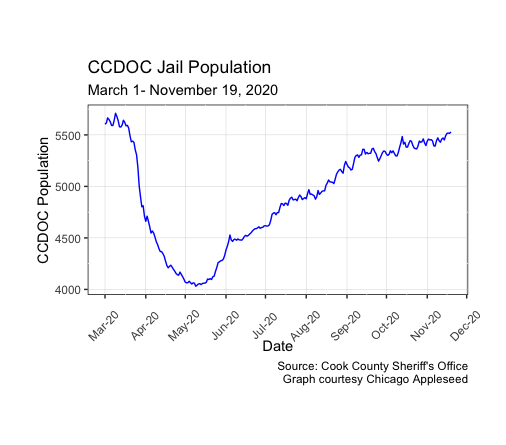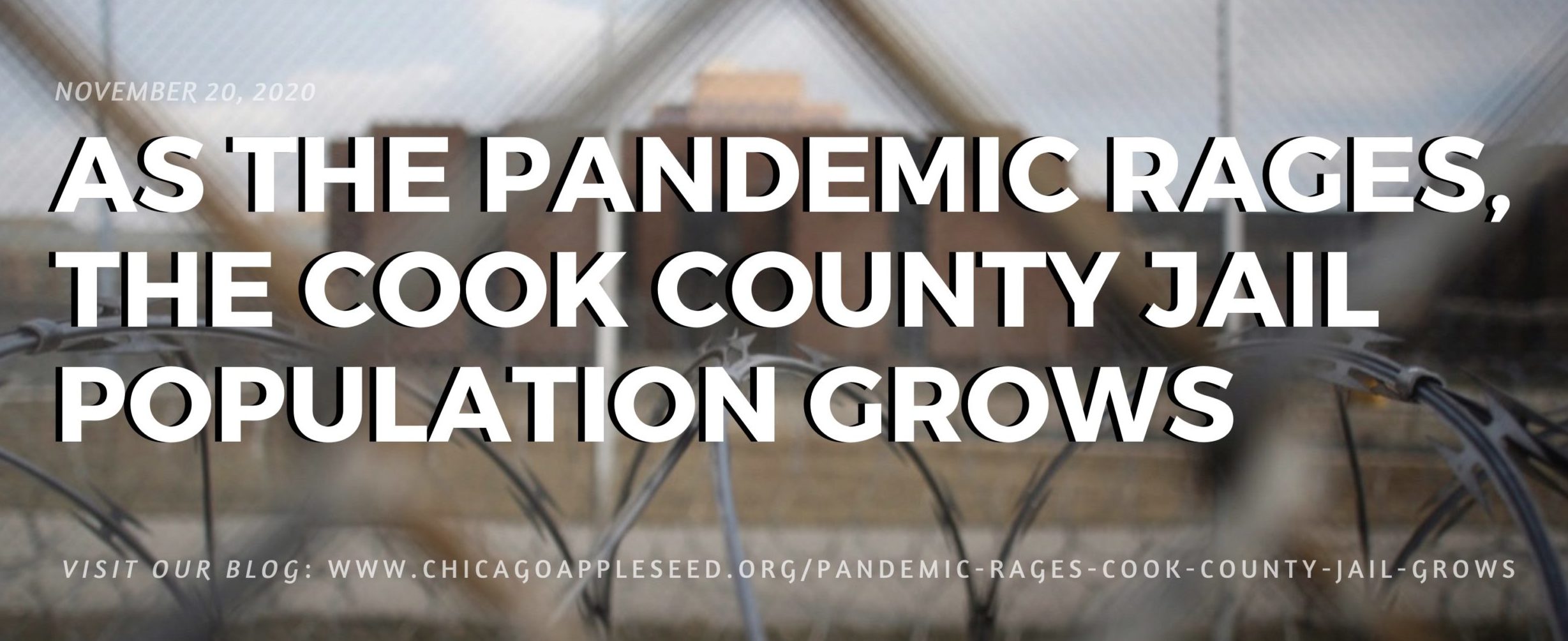As the Pandemic Rages, the Cook County Jail Population Grows
As we embark on the ‘third-wave’ of the pandemic in the United States, we have tragically learned many things. First and importantly, we have learned that the best and only truly effective way to prevent the spread of this airborne virus is by physically distancing ourselves from others. We have also confirmed what we already knew: that social distancing is fundamentally impossible in jails and prisons without significant, consistent, and pointed decarceration.
When Sheriff Dart was sued earlier this year for his failure to respond to the unique risks the virus posed to those forced to live in the jail during the pandemic, the lawsuit (Mays et al. v. Dart) confirmed that conditions at Cook County Jail were, in fact, dire at the beginning of the pandemic. People detained and jail staff alike reported insufficient access to soap, hand sanitizer, and face masks, and no regular sanitizing of common surfaces.

Community-led advocacy, hard work from civil rights lawyers, Public Defenders, and the State’s Attorney, and this eventual litigation finally mitigated some of the spread of COVID-19 by significantly reducing the jail population – but for the past nine months, advocates in the city and across the country have continually warned about what would inevitably happen when the jail population rose again.
On July 23, 2020, Chicago Appleseed published a blog post entitled, “We Should Not Declare Victory Prematurely: Fight Against COVID-19 at Cook County Jail is Far From Over,” after Sheriff Tom Dart told the Cook County Board of Commissioners, at a budget hearing, that he was responsive to the needs of people living in the Jail on “day one” of the COVID-19 pandemic; that same week, he told the Chicago Tribune that he responded in the “quickest and most massive way.” We know this to be untrue because, as the Judge in the Federal Lawsuit stated:
Permit[ting] the Sheriff to lift measures [would] thereby again place the health of detained persons at serious risk. That risk cannot be discounted based on the Sheriff’s assurances alone. Again, a number of the measures he took were instituted only after the Court’s TRO or preliminary injunction.
Our concern with Dart’s premature declaration of victory was, unfortunately, warranted. Today, the Cook County Jail population is significantly higher than it was in the Spring, with 5,511 people inside. On November 16, 2020, 85-year-old Harold Graszer died while awaiting trial; he was the eighth person known to have died from COVID-19 complications while in the custody of the Sheriff, and the first to die in over 7 months, since William Sobczyk on May 6, 2020.
Senior Policy Analyst & Staff Attorney for Chicago Appleseed and the Chicago Council of Lawyers, Sarah Staudt, examined Sheriff’s Dart’s jail roster data (obtained through a FOIA request) and found that as of October 31, approximately 1,008 people were incarcerated for low-level (non-forcible, not firearm-related) charges like Narcotics, Possession of a Stolen Motor Vehicle, DUI, and Retail Theft–over 220 for Narcotics or Cannabis only, and more than 40 were charged with Retail Theft alone. Around 98 people whose highest charges were Class 4 or below had already served at least 6 months in the Jail and there are at least 328 people on house arrest (which also gets day-for-day credit for time-served before trial) in that same situation. The vast majority of Class 4 felonies are given either probation or a 1-year term in prison (which translates to 6 months of actual prison time). These individuals have likely already served more time in custody than they will if they are ultimately convicted.
Since the Cook County Chief Judge implemented General Order 18.8 in 2017, Cook County’s average jail population has declined by about 16%, while at the same time, overall crime has continued to decline. Still, Cook County Sheriff’s data showed that as of October 31, 2020, 1,423 people were in the Jail only because they couldn’t afford to pay the bond amount set by a judge. Cook County Court rules state that judges are required to consider ability to pay in making these decisions, but over 590 of these people needed to post $10,000 or less to bail out and over 130 people needed to post $1,000 or less. Of those really low bonds, approximately 65 people were charged with non-forcible, non-gun related crimes, and were in jail solely because they didn’t have access to $1,000 or less.
As the pandemic rages on and the jail population continues to grow, so too does our level of concern that some of the lessons we learned early-on have been lost somewhere along the way. When the pandemic began, people in Cook County Jail were made to sleep in beds that were only two or three feet apart, with dozens sharing a single room until the population was finally reduced–we are now back to square one. Decarceration has proven safe and effective, with over 99% of people free of any new “violent” charges and over 80% remaining totally “charge-free while their cases were pending” between October 2017 and December 2018. It is absolutely essential that every Cook County and City of Chicago official does everything in their power to reduce the population of the Cook County Jail.
Visit Chicago Community Bond Fund for more information about how to call on your Cook County elected officials to take action to drastically reduce the jail population: https://chicagobond.org/2020/11/17/eighth-person-dies-of-covid-19-while-in-the-custody-of-cook-county-jail/

